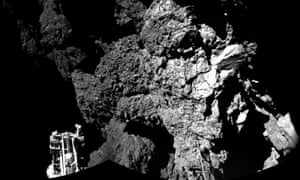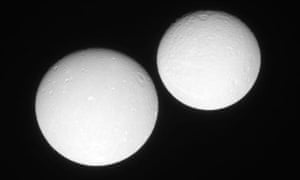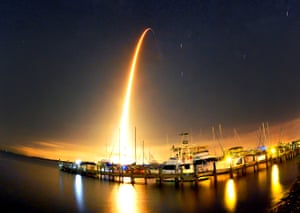Extract from The Guardian
Major Tim Peake became Britain’s first career
astronaut to make it into orbit – but scientific advances and Pluto
discoveries were even bigger news
Russia’s Soyuz
TMA-19M spacecraft carrying Tim Peake, Russian cosmonaut Yuri
Malenchenko and US astronaut Tim Kopra blasts off from Baikonur.
Photograph: Kirill Kudryavtsev/AFP/Getty Images
Science editor
Saturday 26 December 2015 05.00 AEDT
When the Soyuz rocket carrying Britain’s Tim
Peake blasted
off from Baikonur cosmodrome in Kazakhstan this month, he took
much
of the nation with him. He is not
the first British astronaut and not
even the first from Sussex, but he is the only one ever admitted
to the European
astronaut corps. That makes a difference. As a career astronaut
for the European Space Agency, Peake is uniquely placed to inspire
British children for many years to come. The launch was a
historic moment, but far from the only highlight of 2015.
It was already an exceptional year in space. The
face of Pluto
emerged from the gloom to reveal a dazzling landscape of ridges, ice
mountains and plains of solid nitrogen hundreds of miles wide. Robots
on the ground and in the sky above Mars found ancient water marks and
then evidence that water flows there today, leaving dark streaks on
the walls of craters and gullies. Another probe plunged through
frigid geysers that spray from Enceladus, one of Saturn’s moons :
the vapour propelled by hydrothermal energy in a global ocean under
the surface.
For one group of British scientists 2015 began
with a bittersweet discovery. Images from Nasa’s Mars
Reconnaissance Orbiter revealed the fate of the Beagle 2 spacecraft.
Not
seen since Christmas 2003 when it parted from the European
orbiter, Mars Express, the pictures showed the unmistakable Mickey
Mouse-shaped remains of the little lander. Partially opened, its
outer cover apparently nearby, the images showed how close the budget
mission had come to success. “I had given up on ever knowing what
happened to Beagle. After so many years you think you’ll never
know,” said Mark
Sims, the project’s mission manager at Leicester University.
“It had obviously gone through its whole landing sequence and had
started to deploy itself. When I first saw the images, I thought ‘My
God, it might actually have made it’.”
An artist’s impression of Beagle 2.
Photograph: European Space Agency/PA
Photograph: European Space Agency/PA
It was not the last we heard from Mars. In March,
Nasa drew on the world’s most powerful telescopes to show that the
red planet once hosted a vast,
ancient ocean that covered nearly half of the northern
hemisphere. That Mars had once been warm and damp was nothing new,
but the amount of water was a revelation. The scientists envision the
north of Mars under around 20 million cubic kilometres of water, more
than is found in the Arctic ocean. The huge body of water stood for
millions of years but as the atmosphere thinned the ocean was lost to
space. What remains, a mere 13% of the water, is locked up in the
planet’s polar ice caps.
More breathtaking, though, was the finding in
September that there is liquid
water on Mars today. The Mars Reconnaissance Orbiter, the same
probe that found Beagle 2, had swung around the planet taking
pictures of strange dark streaks that appeared on crater walls and
canyons during the planet’s summer months. Infrared analyses of the
images found the hallmarks of hydrated salts on the surface, but only
when the streaks were present. It looked a sure sign that liquid
water was either condensing on the surface, or rising up from the
briny reservoirs in the ground.
Hale crater on Mars, showing Nasa’s Mars
Reconnaissance Orbiter signs of liquid water. Photograph: NASA/Getty
Images
Water is regarded as a prerequisite for life, or
at least for life on Earth. The discovery that water flows on Mars
means the planet may, in some parts, harbour niches where microbes
evolved and exist even now. That would be in line with the discovery
of methane
plumes on Mars last year, though chemical reactions on rocks can
release the same gas.ment
The prospect is tantalising but the practicalities
are frustrating. To find life elsewhere would answer one of the
greatest questions of human existence. But there is a glitch.
Planetary protection guidelines say that robotic landers must not
spread Earthly microbes to sites where life might exist on other
planets. Nasa’s
Curiosity rover was not sterilised before launch and so is not
clean enough to venture on to Mars’s damp patches. Nor is its twin,
a rover planned for launch in 2020. It is a quandary that scientists
may work around though. Trundle about on Mars for long enough and the
radiation may kill off any microbes that hitched a ride. Expect more
in 2016.
“It looks more and more like Mars was a very
habitable world three to four billion years ago,” said Monica
Grady, professor of planetary science at the Open University.
“What we don’t really know is: did life develop there? If you
asked me 20 years ago I’d have bet heavily against the possibility
of life. But nowadays we know Mars was a pretty habitable place. The
question is: did it start and did it go anywhere?”
Between Mars and Jupiter, a spacecraft named Dawn
became the first to visit a dwarf planet. At 300 miles wide, Ceres is
the largest object in the asteroid belt. As Dawn approached, two
mysterious
shiny spots became clear on the surface. The nature of the bright
patches sparked a debate among astronomers, with the latest spectral
images from the spacecraft suggesting they are not ice, as some
suspected, but salts.
The surface of the 67P/Churyumov-Gerasimenko comet
as seen from the Philae lander, which stirred back to life this year
after extra sun fell on its solar panels. Photograph: Handout/ESA via
Getty Images
The European Space Agency’s Rosetta
spacecraft, the first to drop a lander on a comet, continued to orbit
the body, sniffing
oxygen in its gas cloud and flying close enough to film its own
shadow on the comet’s surface. The Philae lander which landed not
once, but thrice, fell silent three days after touchdown. But as the
comet neared the sun and more light fell on its solar panels, Philae
stirred to life again, long enough to call Rosetta. The moment
was the highlight of the year for Grady, who works on the Ptolemy
instrument onboard. “It powered up and it could still happen
again,” she said. For now, the comet is too active for Rosetta to
fly close enough to make contact.
Cassini spacecraft image of Saturn’s moons Dione
and Rhea. The distance between Dione and Rhea was roughly 330,000km
(205,000 miles). Photograph: HO/Reuters
Meanwhile, on the sixth moon of Saturn, Nasa’s
veteran Cassini probe went looking for signs
of life. The spacecraft dived
down to Enceladus and passed through geysers that erupt from a
saline
ocean under the surface. Scientists are still analysing the
chemicals detected in the plume. If they turn out to include hydrogen
gas, researchers would have good evidence for hot vents at the bottom
of the moon’s ocean and good reason to consider Enceladus the most
promising place to find life beyond Earth.
Orbiters and rovers have peered and poked at Mars
for a long time. But other corners of the solar system had gone
unexplored until this year. As John
Bridges, a planetary scientist at Leicester University, puts it:
“2015 was the year of the outer solar system.” It was an
important year for images too. For 85 years, the best pictures we had
of Pluto
showed no more than a blurred blob. In July, the US space agency’s
New Horizons probe changed
all that. Barrelling past the dwarf planet on the edge of the
solar system, the spacecraft captured Pluto in all its staggering
beauty.
“It’s opening up our view of the outer solar
system,” Bridges said. “We have this idea of the outer solar
system being this cold, inert place of dust and ice. But the key
thing now, when we get a close-up view, is that there’s geological
activity going on out there.” Inactive planets and moons are pocked
with ancient impacts but active ones look different: the ground is
turned over and refreshed. The Pluto images showed clear signs of
activity in the form of giant regions of smooth, young terrain.
“These are halcyon days for planetary science,” said Bridges.
“There’s no question about that.”
The year produced, a fine demonstration of the
fates of space hardware. In April Nasa crashed its Messenger
probe into Mercury
once it was done mapping the planet. A month later, the Russian cargo
ship, Progress
59, fell back to Earth after going wrong en route to the
International Space Station. In the race to develop a reusable
rocket, Elon
Musk’s SpaceX failed
to land its Falcon 9 rocket on a barge at sea and then succeeded
on land, while Jeff
Bezos’s Blue Origin company landed its New
Shepard rocket at a West Texas launch site. He
made sure the world knew, too.
Elon Musk’s SpaceX Falcon 9 rocket lights up the
sky. Photograph: Craig Rubadoux/AP
With ever more powerful telescopes on the ground
and in space, astronomers added to the haul of thousands of planets
spotted beyond our own solar system. One is Kepler 438b, claimed by
Kepler mission scientists to be the most
Earth-like planet found to date. But the alien world, which lies
470 light years away, is not the most habitable. Intense blasts of
radiation from the planet’s host star are thought to have stripped
the atmosphere, leaving the planet Earth-sized but less than
Earth-like.
The search for life beyond Earth took an
extraordinary turn in October when an astronomer from Penn State
University suggested that strange signals around a distant star might
be the signature of a swarm
of alien “megastructures” in orbit around the planet. In
December the possibility, which was seriously speculative from the
start, was dealt a blow. Scientists dedicated to the search for
extraterrestrial intelligence (Seti) used an observatory in Panama to
look for signs of life around the star and found
none.
Those impatient for contact with alien life should
not lose heart though. The world’s
most comprehensive search for ET begins in earnest in January
with backing from Yuri Milner, the Russian internet billionaire.
Backing the launch earlier this year, Stephen Hawking said: “Mankind
has a deep need to explore, to learn, to know. We also happen to be
sociable creatures. It is important for us to know if we are alone in
the dark.”






No comments:
Post a Comment